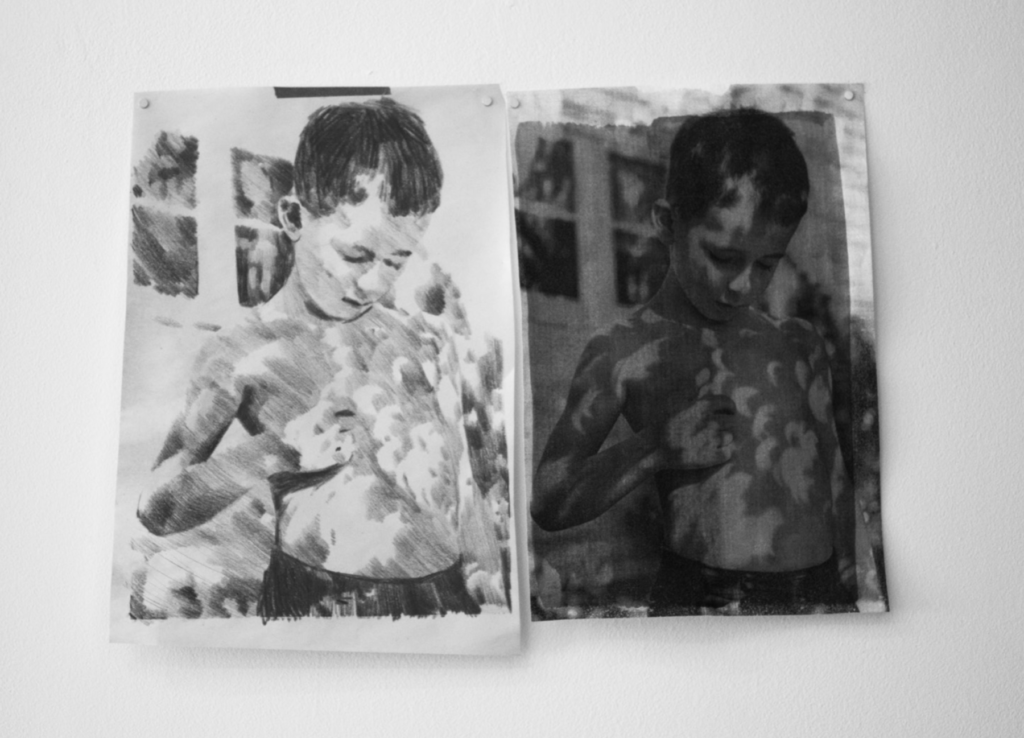Isa Newby Gagarin: Heliotuduc
Review by Mia Lopez
The White Page
Mar 11–Apr 8, 2016

The White Page in South Minneapolis is one of a handful of alternative spaces that have appeared in the Twin Cities over the past three years. Founded in 2013 by a four person collective, the exhibition and residency program has easily found an audience with like-minded emerging artists and locals eager for new voices and perspectives. The White Page and its creators chose Minneapolis as their home because of the dynamic local artistic community, but also recognized a need for more opportunities for young artists. As an artist-run space, the organization adheres to a mission of collaboration and immersion, providing a myriad of means through which exhibiting artists and residents might present work or explore their practice. Dialogue and community are central to The White Page, and have helped establish the space as an invaluable resource.
The White Page currently features a solo exhibition by Minneapolis based artist Isa Newby Gagarin. In Heliotuduc we find Gagarin combining phototransfers, newsprint, textiles, and paint to create objects that are neither paintings, nor photographs. Instead, the vibrant panels installed irregularly throughout the gallery are the product of the artist’s ongoing investigation of material and light sensitivity. Her application of pigment echoes sun streaming through stained glass windows, at once bright and translucent yet vividly colored. While many works are abstract layers of color and tone, others are nebulous impressions of familiar scenes. The façade of a house, shrouded by the shadows of trees. An object that is reminiscent of a satellite but is actually a colander. A shirtless child, oblivious to the camera and cast in shadows and bright light. Yet even when employing recognizable forms, Gagarin’s images are puzzling, leaving the viewer curious about their origins and attempting to find a narrative.
Although no curatorial statement or individual titles are provided, the exhibition name may be a source of some elucidation. Heliotuduc is a word created by the artist with roots in science and history. Helio is borrowed from heliotropism, a term with Greek origins that describes the phenomena of plants or organic objects growing towards or away from sunlight. Tuduc is a reference to a Romanian rug forger Theodor Tuduc, who was acclaimed for his skillful recreations of antique rugs. The White Page also provides a short text written by the artist that provides further references to Tuduc, as well as other clues for the viewer to decipher. Gagarin reproduces fragments of a conversation with Shadia Habbal, solar physicist at the Institute for Astronomy at University of Hawai’i, wherein the two seem to discuss solar eclipses. The language is vague, but is clearly source material for the artist, whose previous work has also engaged with astronomy. In another particularly playful quote, a 16th century scientist describes plants rejoicing in the presence of the sun. Elsewhere in the text Gagarin returns to a discussion of textiles both in reference to Tuduc and as a prolific craft.
Taken as a whole, the text seems illogical, a mishmash of quotes without any cohesion to bind them together. And yet, the exhibition fills in the blanks, providing context for the statement while also existing as a distinct body of work. Should the text function as lab notes, the work is the experiment, repeated, annotated, and examined until the desired results are achieved. Still, though I appreciated the conceptual function of the artist’s statement, I found myself wanting more.
I paid a second visit to Heliotuduc for an evening of music, organized in conjunction with the exhibition. The White Page regularly hosts performances in their space, both as stand alone events and as complimentary exhibition programs. Not only are different artists given the opportunity to share their work, but patrons to the gallery are given a different type of art viewing experience. I returned seeking a deeper connection to Gagarin’s work, and an alternative perspective on her aesthetic. The night I visited, the musicians were set up against the gallery’s far wall, dimly lit by a warm light. A dozen or so listeners sat on the floor, while others lined the room’s perimeter, drinks in hand and quietly chatting. As I listened to Tabitha Sheets create electronic verberations and vocal loops, I was struck by the transformation of the gallery, and the exhibition, in the dark. There was a sense of intimacy created in the low light and close quarters as a recording of Sheets’ breathing was mixed and manipulated through the speakers.
At night, Gagarin’s once lackadaisical seeming installation of images drew to mind the darkroom, with photos in different stages of development tethered loosely to the walls. What had been a coherent, if not wholly compelling exhibition during the day now seemed like works in progress, waiting to be edited and revised. Contemplating the artist’s process and the relationship of Heliotuduc to her larger practice and perhaps her relationship to other artists and spaces, I came to an epiphany. Heliotuduc is an ephemeral, site specific project. The White Page is a space that allows artists to take risks, and to present their work to peers. Thus, Gagarin has allowed the viewer a rare insight into how her work is created, presented in the form of an exhibition. Her photosensitive materials may seem fixed, yet they are still developing, exposed to the light of the gallery. Yes, for now the images are beautiful and mysterious but their final form still remains to be seen.
